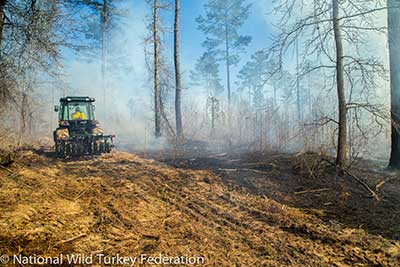Wild Turkey
By Rick Horton, National Wild Turkey Federation
Wild turkey, the largest game bird in the country, has adapted to a wide range of habitats across the continental United States, including in Wisconsin. While it was once thought turkeys could only survive in large tracts of old growth timber, it’s now known they do best in a mix of forested and agricultural lands. In spring, the home range of an individual gobbler is around 500 acres, while in summer and fall it drops to about 150 acres.

Habitat needs
For breeding, nesting, and rearing young, wild turkeys generally require a mixture of forest cover and open areas. More specifically, they need:
- Breeding habitat: Secure, open areas for gobbling and strutting. Open woodlands, grassy fields, and forest openings are all used.
- Nesting habitat: First nesting attempts are usually made in open oak forests with overhead cover. If the first nest is destroyed, later nests will be built in grassy fields, hay fields, or forest openings.
- Brood-rearing habitat: Young turkeys feed mostly on insects so the best brood habitats are grassy areas with a diversity of flowers that hold a lot of bugs. These include forest openings, grasslands, old fields, meadows, pastures, grain fields, and hayfields close to wooded cover.
Turkeys roost in trees overnight to avoid predators on the ground. Woodlands with large pole-sized or sawtimber-sized trees with horizontal branches offer the best roosting habitat.
In winter, open oak woodlands with south-facing slopes and open springs are the ideal turkey habitat; abundant acorns are critical for high quality habitat. Winter roosting is done usually in conifers, where available.
Turkeys are opportunistic when it comes to diet, choosing a wide variety of foods throughout the year. Standing corn, corn stubble, and manure-spreading operations can also provide extra food in winter. In severe conditions, turkeys have been known to pick buds as grouse do.
Recommendations for attracting more turkey

Pastures and meadows
Grasslands and grass/forb openings should be maintained so that the grass isn’t too tall or thick for young turkeys (poults) to walk through and doesn’t obscure the vision of a strutting tom. Long, linear forest openings are preferred.
Vegetation can be maintained through periodic burning, mowing, grazing, or hand removal of invading woody species. Planting forage legumes such as alfalfa or clover will also encourage turkeys to feed in openings and to breed.
Woodlands
The most important type of turkey habitat in the upper Midwest is the open oak woodland. Oak woodlands provide many of the bird’s year-round requirements, including food and cover, shelter from weather, and habitat for breeding, nesting, roosting, and loafing.
Woodland management practices that favor an open oak forest will provide habitat for turkeys for many years to come. Selective thinning, shelterwood cuts, clearcuts, and post-cut treatments or prescribed burning are all prescriptions for individual woodlots; however, it’s important to know which of these practices is most suitable for your forest. Consult with your local forester or wildlife biologist for specific advice.
